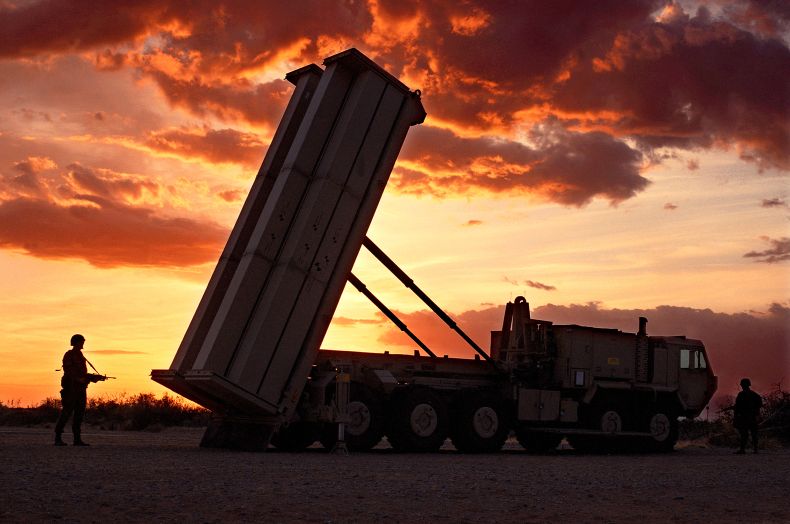
THAAD Battery Launcher. (Lockheed Martin)
OPINION: A clear theme emerging from the speeches at this week’s Space and Missile Defense Symposium is that US air and missile defenders are falling behind, and need new systems or technologies to protect troops abroad and citizens at home. But in a world of proliferating precision weapons and improving penetration aids, US forces are unlikely to regain the upper hand with better interceptors and radars alone.
By reframing air and missile defense as an enabler, the Pentagon can better define its needs and reveal new approaches to achieve more resilient US operations.
The recent Nagorno-Karabakh conflict showed how off-the-shelf networks and improvised guided weapons can create devastating impacts. The US military is aggressively refining its defenses to counter the kinds of weaponized UAVs used in that confrontation, which only highlights the tail chase DoD faces when it treats raid annihilation or probability of kill as the primary metrics for air and missile defense.
The goal of defeating every threat only becomes more challenging against peer competitors like China and Russia, whose weapon inventories in East Asia and Europe, respectively, are sufficient to overwhelm US defenses. As the away team in potential conflicts with these adversaries, US forces will always be at a numerical disadvantage. And at home, it is unlikely defense budgets will support the kind of capacity needed to protect all potential targets from cruise missile attacks, much less counter advancing Russian and growing Chinese ICBM threats.
Given that perfect or near-perfect protection will usually be unachievable, policymakers often treat air and missile defense as a hedge against small attacks an enemy may launch to gain escalation dominance or test US resolve. DoD’s current air and missile defense budget appears to reflect this perspective, steadily modernizing systems but not significantly increasing capacity or capability to counter improving and proliferating threats.
Pentagon leaders need to be more effective with their missile defense investments and posture decisions. We see three changes that need to happen to embrace the inevitability of air and missile defense shortfalls.
First, reframe missile defenses in terms of the missions or operations they are intended to protect. For example, sustaining air operations from Okinawa would be a key operational problem for US Indo-Pacific Command during a confrontation against China. Using a metric like air sorties enabled would provide a framework for assessing the value of competing investments and activities, including air and missile defense, and making choices. The next marginal dollar may, for instance, be better spent on runway repair capabilities instead of buying a new Patriot battery.
Second, defense planners will need to accept risk. With a finite number of launchers and electromagnetic warfare systems to go around, important targets like command centers or fuel farms may not be fully defended. Accepting capacity shortfalls as a fact of life would help decision-makers reallocate funding to other solutions for operational problems, such as mobile air control centers, alternative fuel distribution systems, increased ramp space, or hardened hangars to sustain air operations from Okinawa. Overall, DoD’s approach will need to shift from one that continues to assume a largely uncontested environment to one that pursues resilience, such as described in Indo-Pacific Command’s Pacific Deterrence Initiative proposal.
Third, air and missile defense forces should adopt a disaggregated model that can scale, incorporate new systems, and respond to adversary actions. An air and missile defense architecture could combine an integrated Aegis Combat System as a command and control node with disparate fixed and mobile radars, electronic warfare systems, and mobile missile launchers to align air and missile defense capability and capacity to the potential enemy tactics and needs associated with different defended assets.
The flexibility of a disaggregated architecture would increase options for US forces and constrain those for the enemy. For example, instead of predictably assigning all five batteries of an air defense artillery battalion to unsuccessfully guard Kadena Air Base’s highest-priority targets, a disaggregated architecture could rely on passive space or ground-based sensors for cueing and use the radars of two batteries for missile tracking and engagement around targets lacking backup capabilities, such as fuel farms. Some batteries could remain passive, to add capacity through remote operation or later activation. Others could relocate to challenge enemy targeting or employ decoys to mimic the presence of real batteries. During an attack, the battalion’s overall capacity would likely be lower than if all its batteries were radiating; however, it will be better able to continue contesting the local airspace and enable efforts to get the airfield back in operation.
Focusing on supported missions, accepting risk, and adopting disaggregated architectures would make air and missile defense capabilities and operations less predictable and static, improving the US military’s adaptability and imposing uncertainty on opponents. More flexible approaches centered on operational problems would also make US air and missile defenses more relevant to a range of scenarios, rather than a few short high-end confrontations like a Taiwan invasion. Without a more holistic way of investing in resilient operations, US air and missile defenses will become increasingly brittle—more capable and numerous, but always behind the threat and vulnerable to being overwhelmed.
Bryan Clark is a Senior Fellow at the Hudson Institute. Timothy A. Walton is a Fellow at the Hudson Institute.






















